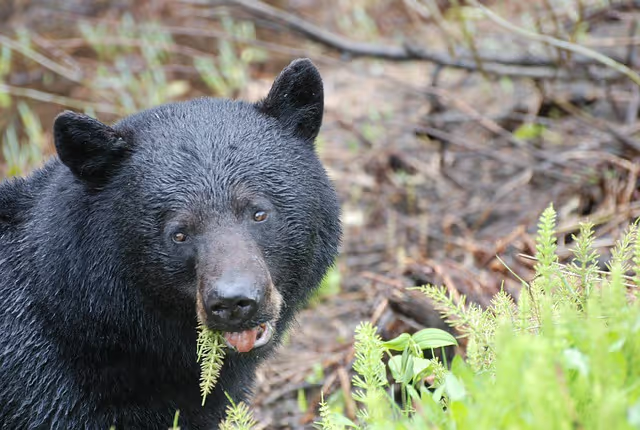Everything You Need to Know About Black Bears: Part 3


Welcome to the third part of our "Everything You Need To Know About Black Bears" series. Over the past two months, we have introduced you to this most interesting species. This time, we're going to take a look at a bear's diet and what you can do to help keep Black Bears from becoming habituated to human food sources. Let's start with their diet.
Diet: Natural Sources and Human Sources Abound
Black Bears have curved claws which help them climb trees to search for food (1). However, they are not as well adept at digging for food as a brown bear. Black Bears are highly intelligent, and are capable of identifying food by both smell and appearance (1).
Black Bears will eat just about anything. They are omnivores, which means that they will eat both plants and animals. Berries are a primary natural food source (2), as we discussed previously. However, they have an array of natural food sources, including fish, insects, larvae, grass, succulent plants, honey, and roots. Additionally, they will hunt and kill deer, moose, and elk (3). Livestock are also the menu for bears, with sheep being a particular favorite (3, 4).
You might think that these natural food sources would be enough to satisfy a Black Bear's appetite. However, they will peruse any food source that will give them an easy meal. Unfortunately, we humans have given Black Bears several sources for easy meals. These include garbage, pet food, fruit trees, and livestock feed. Black Bears that use these human-associated food sources can become habituated to them very quickly and stop relying on natural food sources (3). Unfortunately, this can lead to bears being deemed "nuisances" and euthanized, as the people of North Bend found out earlier this summer (5). Therefore, if we want to continue to safely coexist with Black Bears, we need to keep them from getting access to unnatural food sources.
Don't Feed Bears
The first step is a simple one: don't deliberately feed bears. Sometimes, people will leave food out for bears so that they can take pictures of them (6). While taking pictures of Black Bears can be fun, your yard, porches, and decks are not places where Black Bears should be spending time. More than ninety percent of conflicts between humans and Black Bears are the result of bears becoming conditioned to associate food with humans. It only takes one experience of a bear eating human food to permanently condition them, which sends them down an unfortunate path that can lead to relocation or, if they become too dangerous, death (6). No picture is worth a bear's life.

Manage Your Garbage
The second step is to manage your garbage. This was the mistake my family made that lead to bears getting into our garbage here in Ocean Shores back in May. While Black Bears may be "lazy," they are anything but that when it comes to getting into your garbage. They will expend a great amount of effort and time getting around barriers to access your garbage if the mood takes them (3), even if that means getting into your home, as one bear at Lake Tahoe did earlier this year (7, 8). To prevent this from happening, my family made a couple of adjustments to our garbage routine.
First, we stopped putting our garbage and recycling bins out the night before the rubbish collection trucks come. Instead, we began putting them out the morning of pickup. This gives bears less time to get into them, thereby making it less likely that they will do so again.
Second, we ordered locking bins from Lemay, which provides the rubbish collection service here in Ocean Shores, and began using them. Residents in Ocean Shores city limits can order locking bins by contacting Lemay. Currently, the bins will add $2.50 a month per bin to your bill. However, that is a small price to pay to prevent yourself from having to clean up the mess a bear will inevitably make it if gets into your bin. It will also help keep your neighborhood from having to contend with human-food habituated bears. If you're not in Ocean Shores, check with your rubbish collection provider to see if they offer locking bins. If so, we recommend getting them. If not, ask your provider about installing your own locks onto your bins.
While we have seen bears in our neighborhood a few times since their date with our garbage bin back in May, they have not gotten into the bin since we made these adjustments. Instead, they have simply passed through without causing any trouble.
There are some additional steps that you can take to keep bears out of your garbage.
Take Down Bird Feeders
The third step is one that some of you might not enjoy. That step is to take down your bird feeders. Bears love getting into bird feeders and eating the contents. While bird feeders can help birds get enough to eat, especially in the winter months when fewer natural food sources are available, they are prime targets for bears in search of an easy meal. Therefore, in places where there is a lot of bear activity, such as Ocean Shores, it is best to take them down, particularly during bear season.
Next Time
That concludes the third part of our "Everything You Need To Know About Black Bears" series. Next month, we'll conclude our series by outlining what you need to do if, heaven forbid, a Black Bear decides to attack you. See you in October for this important, potentially life saving information!
References
© Ian D. Caldwell, September 2022
Touch whale bones, examine shipwreck artifacts and connect with the coast's living history.

Support our mission, get involved in educational programs, or contribute through donations and volunteering.